Bigfoot Encounters
What do we know about Sasquatch hair, really?

© Bobbie Short …
and the competence of the investigator varies greatly.” (Krantz)
The first thing most of us in research read about as regards any hair analysis was printed in John Green's 1978 Book, Sasquatch, the Apes Among Us on page 284. On that page John explained a half dozen light colored hairs found in the 1960's by a government game guide named Wayne Twitchell that were subsequently sent to a laboratory in Los Angeles. There, Ray Pinker, a veteran of 36 years in police crime lab techniques examined the hairs issuing a statement that the hairs showed both animal and human characteristics; interestingly, they did not match any samples Pinker had in his collection. He said that they resembled animals hairs in showing a variation of color and thickness from the root to the tip, whereas human hair is uniform in color and thickness, but that the scale pattern on the outside of the shaft was similar to that of human hair and that there was no continuous medulla, or core visible in the center as would be the case with almost all animal hairs. There were both coarse outer hairs and fine hairs from an undercoat.¹ On the two pages cited, John relates what a laborious and thankless task identifying hairs really is and how quickly he lost interest in the process.
Then in 1992, Dr. Grover S. Krantz published Big Foot-Prints: A Scientific Inquiry into the Reality of Sasquatch. On page 128 he writes: “It is now possible to extract DNA from a hair sample to determine the species, or even exact individual if there is a known specimen for comparison. This is easiest done with a follicle, but just a hair shaft will often suffice.”
On the issue of Sasquatch hairs, Dr. John Bindernagel writes in his book “
Walter Birkby at the
Anthropologist Dr. Carleton S. Coon, Ph.D., in his paper, "Why There Has to Be a Sasquatch" wrote:
In November 1995 tufts of hair known as the 'Sumerlin hairs' were found in the Blue Mountains of Washington State, consisting of a dozen strands. These hair samples were sent to Dr. Paul Fuerst, a professor of molecular genetics at
Dr. Bryan Sykes, Professor of Human Genetics at the Oxford Institute of Molecular Medicine, one of the world's leading experts on DNA analysis has been linked to the problems with homin hairs, but to my knowledge, he has not examined hairs presumptive for the North American Sasquatch. The hairs Sykes examined were obtained by zoologist Dr. Rob McCall who was along on the Bhutanese expedition in 2001. If I remember rightly, McCall found hair evidence in the hollow of a cedar tree and at the time, took them to the
In Sumatra in 2004, long strands of hair beside a tiny human-like footprint near Gung Tujuh, SE Asia's largest freshwater
In the past, we were told that the mtDNA generally fragmented too easily to allow for sequencing, but I understand there is an updated process that facilitates the extraction of follicular material from the hair, that is, if it is present in the samples and there is no contamination. I was pleased to read in Paulides & Pratt's 2009 book, Tribal Bigfoot, page 372-3 of the relatively new PowerPlex™ 16 test kit, I urge you to review the letter from the laboratory on those pages. One encouraging sentence in that letter reads, “…at this time it cannot be ruled out that this could be DNA from an undocumented species.”
One final note regarding Sasquatch hair was added to this work on November 7, 2009, and it came from Dmitri Bayanov in Moscow: "A friend wrote me that Bigfoot hair "doesn't follow normal characteristics associated with other primates, why? Nobody knows!" So I consulted Dr. Fahrenbach and received this advice:
Dear Dmitri,
"The probable reason that no unfragmented DNA can be extracted from BF hair is probably the absence of a medulla, which normally - and in most human hairs - contains cells with more preserved interiors and less keratinization. Hair normally falls out in the telogen stage, when the root has totally involuted. A good root is only found when the hair has been pulled out forcibly in the anagen, or fully growing stage. I wouldn't make a big deal out of the BF hair being all that different from other primate hair, since many human scalp hairs have no medulla either, but then they don't have other attributes of sasquatch hair, such as the ubiquitous reddish tinge. Incidentally, much cattle hair is also devoid of a medulla, though a fragmentary one is more common." ... W. Henner Fahrenbach, Ph.D. AZ
Moving on, -a quick word search of my database showed hair reported in many colors, the predominant color is, of course, black. Other colors cropped up less often with
The following colors are mentioned also in John Green's massive database: Red, auburn, black, brown, chocolate brown, blue-black, buckskin colored, blackish red, dark gray, grayish white, off-white, yellowish white, silver-back and one surprising piebald coloring with tobiano patterning, ….something those of us equine people can identify with easily because in horses, it's usually a two-tone coloring of black & white - absolutely beautiful markings often with these two colors being expressed together in the tail and mane. One can only imagine how those two colors are expressed in a Sasquatch. That this occurs in a primate certainly must be a very unusual marking and may be another development that has arisen from breeding within a close society, clan or tribe as many of the Sasquatch problems must. It may also be that the white coloring against black hair is in reality the graying of the individual and not tobiano coloring at all.
I discovered that there was no report to be found of a literal albino colored sasquatch in any database I had access too. The skin coloring beneath the hair was usually reported as Caucasian, olive, brown or Negroid. According to the thickness of the haired individual, hair becomes a beautiful natural sun blocking mechanism and against black hair is seen as white skin or Caucasian colored skin by contrast.
As a statistical model, the BFRO database turned out to be a useless tool to add to these statistics because there is no search capability on that website. Still, I was able to also determine from what I had to draw from that hair has been reported and described as curly, straight, wavy, short, long, medium length, wet, dry; and that is was thick, sparse, thin, heavy, fine, coarse, unruly, unkempt, dirty, smelled, was wild, oily looking, matted, silky and several accounts of having “hardly any hair at all.”
Shave off all that hair and you have a human body looking back at you…
So what are we in research to make of the varying degrees of body hair being reported during encounters? The problem of body hair may be as simple as **Hypertrichosis, also known as 'werewolf syndrome,' which is characterized by excessive body hair in abnormal places on the human torso.
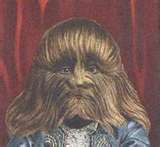 Hypertrichosis is a genetic disorder, extremely rare in humans because of the widely dispersed genetics we have to draw from; however, in a limited gene pool such as the pockets of Sasquatches in northern California (for example) -the gene pool is so dramatically limited making it highly possible that both parents, after generations of in-breeding in a closed society, most probably will carry this recessive gene & will show up in both male & female children in the Sasquatch population. In fact, I'm betting
on that being the riddle of the hair issue. Shave off all that hair and you have a human body
looking back at you…
Hypertrichosis is a genetic disorder, extremely rare in humans because of the widely dispersed genetics we have to draw from; however, in a limited gene pool such as the pockets of Sasquatches in northern California (for example) -the gene pool is so dramatically limited making it highly possible that both parents, after generations of in-breeding in a closed society, most probably will carry this recessive gene & will show up in both male & female children in the Sasquatch population. In fact, I'm betting
on that being the riddle of the hair issue. Shave off all that hair and you have a human body
looking back at you…
 In medical circles it is referred to as hypertrichosis lanuginose, which in simplified terminology means excessive hairiness of the body. For hundreds of years, societies have maintained a certain fascination with the bizarre and the
unknown. In the past, persons with congenital disorders that cause excessive body-hair growth have been so dramatic and romanticized that those individuals with rare hypertrichosis syndrome were, at one time, a crowd-drawing money-making phenomena in many 19th century circus side-show acts. These individuals have in various places in the literature, been referred to as dog-men, hair-men, human Skye terriers, ape-men, werewolves, and Homo silvestris (Brandt, 1897; Felgenhauer, 1969).
In medical circles it is referred to as hypertrichosis lanuginose, which in simplified terminology means excessive hairiness of the body. For hundreds of years, societies have maintained a certain fascination with the bizarre and the
unknown. In the past, persons with congenital disorders that cause excessive body-hair growth have been so dramatic and romanticized that those individuals with rare hypertrichosis syndrome were, at one time, a crowd-drawing money-making phenomena in many 19th century circus side-show acts. These individuals have in various places in the literature, been referred to as dog-men, hair-men, human Skye terriers, ape-men, werewolves, and Homo silvestris (Brandt, 1897; Felgenhauer, 1969).
.jpg) Since the Middle Ages, hundreds of individuals with congenital hypertrichosis have been described, and according to the most recent estimates, approximately 334 cases are documented adequately and definitively in the literature (Baumeister). There are hundreds of other lesser cases of hypertrichosis that are undiagnosed.
Since the Middle Ages, hundreds of individuals with congenital hypertrichosis have been described, and according to the most recent estimates, approximately 334 cases are documented adequately and definitively in the literature (Baumeister). There are hundreds of other lesser cases of hypertrichosis that are undiagnosed.

Women also develop hirsutism, growing *androgen dependent hair in places where men usually grow it. Women with hirsutism might grow hair on their upper lip, chest, chin and along the mandibular jaw line but typically this is caused by a female having an abnormal amount of testosterone in her system...or other male hormones and sometimes the hormonal imbalance is seen in conjunction with having inherited recessive genes from both parents for hypertrichosis. (Both parents must carry this gene in order for it to be expressed in their offspring, or not as is often the case, see Journal of Human Genetics in citation notes). When these factors are bred down through eons of time in a closed society, the current day results could end up with all members of a tribe expressing bodily hair in just about all areas including facial hair on females. I often wonder if this might be the case with the subject in the Patterson film – she sports a moustache, chin whiskers & quite thick facial hair…. is she the exception or the rule? I don't know; what I can tell you is that recent photographs taken in 2009 Canada show this same observable inherited characteristic in facial hair that flows along the mandibular jaw line on a Sasquatch there.
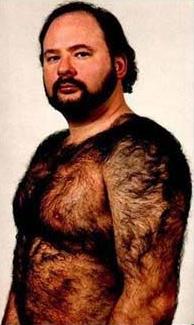
 When during the course of human evolution, did humans shed their thicker primate coats? At some point, thick hair must have become more of a burden than an asset; -scientists have determined a number of potential answers as to how that came about. One theory proposes that early man might have been a water-dwelling ape, and less hair was better suited to his aqueous environment. Another theory explains
it as an adaptation to prevent the spread of parasites, since they thrive in thicker hair, or fur if applicable. Others point to the milestone of bipedalism that occurred around two million years ago. By standing erect instead of on all fours, humans expose only one-third of their bodies to direct sunlight; with that posture, a full covering of hair wouldn't be necessary for sun protection. (Barlow)
When during the course of human evolution, did humans shed their thicker primate coats? At some point, thick hair must have become more of a burden than an asset; -scientists have determined a number of potential answers as to how that came about. One theory proposes that early man might have been a water-dwelling ape, and less hair was better suited to his aqueous environment. Another theory explains
it as an adaptation to prevent the spread of parasites, since they thrive in thicker hair, or fur if applicable. Others point to the milestone of bipedalism that occurred around two million years ago. By standing erect instead of on all fours, humans expose only one-third of their bodies to direct sunlight; with that posture, a full covering of hair wouldn't be necessary for sun protection. (Barlow)
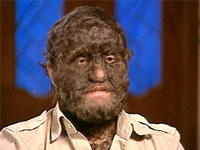 The Sasquatch it seems is a bit more haired than the average Joe, which is why I became interested in the subject of hypertrichosis as a possible reason for the BF hair issues.
The Sasquatch it seems is a bit more haired than the average Joe, which is why I became interested in the subject of hypertrichosis as a possible reason for the BF hair issues.
This has been, more or less a four page review of what we know about Sasquatch hair which turns out to be essentially very little. ….© Bobbie Short, 2009
Dr. Esteban Sarmiento comments on hair HERE
Mike Phillips Sasquatch Research page contains a study of hair color: http://zmphillips.blogspot.com/
-----------------------------------------------------------------------------------------------------------------------------------------------------------------
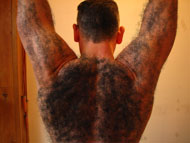 **Hypertrichosis
**Hypertrichosis
*Androgen is the generic term for any natural or synthetic compound, usually a steroid hormone, that stimulates the development of masculine characteristics by binding androgen 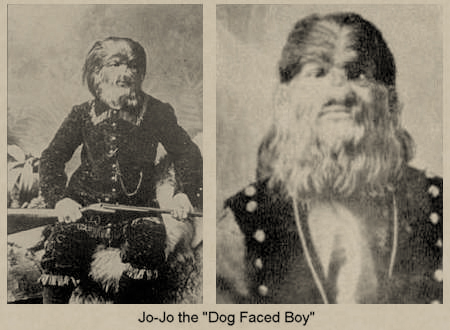 receptors. Androgens are better known as anabolic steroids in sport medicine. Androgens, which were first discovered in 1936, are also called androgenic hormones or testoids. They are also the precursor of all estrogens, the female sex hormones. The primary and most well-known androgen is testosterone!
receptors. Androgens are better known as anabolic steroids in sport medicine. Androgens, which were first discovered in 1936, are also called androgenic hormones or testoids. They are also the precursor of all estrogens, the female sex hormones. The primary and most well-known androgen is testosterone!
Photos of hirsutism and hypertrichosis examples were Internet stock....
¹ Green, John, "Sasquatch, the Apes Among Us" 1978 pg 284
Pinker, Ray, a veteran of 36 years in police crime lab techniques, formerly Los Angeles Police Dept.
Krantz, Dr. Grover S., anthropologist, published
Big Foot-Prints: A Scientific Inquiry into the Reality of Sasquatch” 1992 page 128
²Citation for Fuerst - The Dayton Daily News; Monday, November 6, 1995
³ The Times, London Monday 2 April 2001
The Journal of Human Genetics: A new form of hypertrichosis inherited as an X-linked dominant trait, March 1984 Summary: A family with a distinct form of congenital generalized hypertrichosis was studied. Males were more severely affected than females, who exhibited asymmetric hair distribution. This finding was attributed to ***lyonization, since genealogical studies indicated an X-linked pattern of inheritance. A back mutation is postulated as the origin of this new phenotype.
***Lyonization, A term used for the phenomenon of X inactivation, which was first proposed by the geneticist Mary Lyon. Lyonization also called X-inactivation is a process by which one of the two copies of the X chromosome present in female mammals is inactivated. The inactive X chromosome is silenced by packaging into transcriptionally inactive heterochromatin. X-inactivation occurs so that the female, with two X chromosomes, does not have twice as many X chromosome gene products as the male, which only possess a single copy of the X chromosome. The choice of which X chromosome will be inactivated is random in placental mammals & humans but once an X chromosome is inactivated it will remain inactive throughout the lifetime of the cell. (Puck)
Puck, J (1998) “X Inactivation in Females with X-linked Disease” New England Journal of Medicine
Danforth CH “Studies on hair with special reference to hypertrichosis” Arch Dermatol Syphilol 12:380–401
Felgenhauer WR (1969) Hypertrichosis lanuginosa universalis. J Genet Hum 17:1–44
Barlow, Tom. "How the hairy ape went bald." Financial Times Aug. 29, 1998. Whatever the evolutionary trigger was the sum of those adaptations left humans with sporadic body hair patterns.
Baumeister, Dr. Roy, 1993
The World Reviewer: Orang Pendek or the Little Man of the Forest, October 2004
The Manchester Online dot com, Manchester, UK
"America's Terrifying Woodland Monster-men"
By Warren Smith - SAGA Magazine July 1969 article provided by Ron Schaffner
Bindernagel, Dr. John “North America's Great Ape, the Sasquatch,” 1998
Fahrenbach, Dr. W. Henner Ph.D., Laboratory of Microscopy, 6835 E. Las Animas Trail, Gold Canyon, Arizona 85118
Paulides, David & Harvey Pratt's 2009 book, Tribal Bigfoot, page 372-3
Brunner, Dr. Hans, world renowned hair expert
Chivers, Dr. David,
Davies, Adam, cryptozoologist
Sykes, Dr. Bryan, Professor of Human Genetics, Oxford Institute of Molecular
Fuerst, Dr. Paul, professor of molecular genetics,
Poirier, Dr. Frank, Anthropologist, formerly
Schaffner, Ron, Ohio for his database search & help with references for this article, June 2009
Morley, John, Texas biologist for his assistance with this article.
Foote, Jim & our friend, Sarah in California for their assistance with this article.
Joholske, Ken his 2002 report is filed here:
Back to Bigfoot Encounters Main page
Back to Newspaper & Magazine Articles
Back to Bigfoot Encounters "What's New" page
Portions of this website are reprinted and sometimes edited to fit the standards of this website
under the Fair Use Doctrine of International Copyright Law
as educational material without benefit of financial gain.
http://www4.law.cornell.edu/uscode/17/107.html
This proviso is applicable throughout the entire Bigfoot Encounters Website.